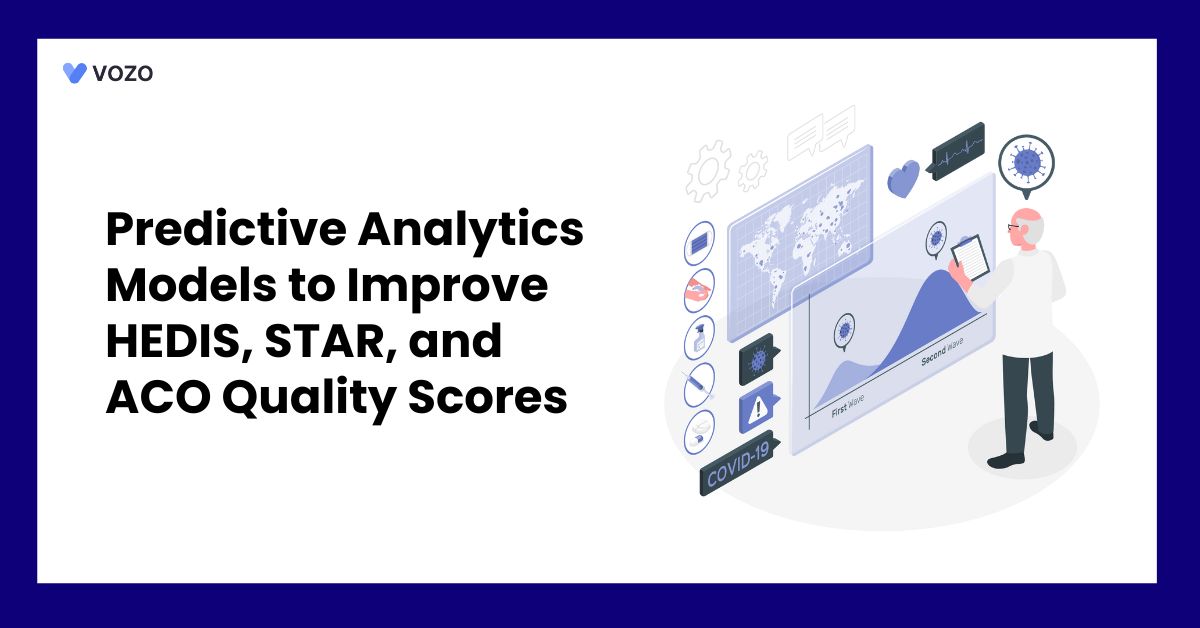Predictive Analytics Models to Improve HEDIS, STAR, and ACO Quality Scores
Healthcare plans and providers use quality measurement programs like HEDIS, Medicare Star Ratings, and ACO quality measures to evaluate care effectiveness, preventive services, and patient outcomes. The Healthcare Effectiveness Data and Information Set is a standardized set of ≈90 measures across domains like Effectiveness of Care, Access, and Utilization.
Today, over 235 million Americans are in plans reporting HEDIS results. The Medicare Advantage and Part D Star Ratings system lets consumers compare plan quality. It covers dozens of metrics (e.g., diabetes control, immunizations, medication adherence) to reward high‐performing plans.
Accountable Care Organizations in Medicare’s Shared Savings Program must also meet quality targets to share in savings. Excelling in HEDIS, Star, or ACO measures drives value-based payments, bonus payments, and a competitive edge in the market.
Quality scores matter because they tie directly to payment and reputation. For example, high HEDIS scores can trigger higher reimbursements and quality bonuses, while even a one-star drop in the Medicare Star Rating can cost plans hundreds of millions in lost bonuses.
ACOs, by definition, share in savings only if they achieve cost and quality benchmarks. In short, improving quality metrics improves patient outcomes and the bottom line, which is why data-driven strategies are essential.
Role of Predictive Analytics in Population Health Management
Predictive analytics uses data science (statistics, machine learning, AI) to forecast future health events and stratify population risk. This lets health organizations move from reactive care to proactive prevention.
For example, by analyzing large datasets (EHR, claims, labs, socio-demographics), a predictive model can flag which patients are likely to develop complications or require hospitalization. Population health programs then focus resources on those high-risk patients, improving overall outcomes.
Studies have shown this shift pays off: one literature review found AI-driven risk models can identify at-risk patients and help providers intervene before problems escalate.
Predictive analytics supports population health in several ways:
- Risk stratification: Scoring each patient’s likelihood of future events. This helps segment the population and allocate care coordinators efficiently.
- Preventive outreach: Identifying members who are due for screenings and immunizations, so they can be contacted before gaps widen.
- Resource optimization: Forecasting demand for services (ER visits, outpatient clinics) to better manage staffing and care pathways.
- Performance tracking: Continuously monitoring risk scores to evaluate if interventions are working, enabling course correction.
Analytics-driven population health is about turning data into actionable insights. For example, predicting who will benefit from care management or extra coordination ensures that outreach improves care rates. One corporate blog notes that predictive models “anticipate health risks before they become serious problems, personalize therapies for maximum effectiveness, and optimize care delivery”.
In practice, this means hospitals flag patients likely to be readmitted for extra follow-up, and payers identify patients missing diabetes or cancer screenings so they can close HEDIS gaps.
Related: Key Benefits of Predictive Analytics in Population Health Management
How Predictive Modeling Improves Quality Scores
Predictive modeling helps health plans improve specific quality measures in HEDIS, Star, and ACO programs by focusing efforts where they’ll move the needle. Some examples:
1. HEDIS measures
HEDIS includes metrics like childhood immunizations, cancer screening rates, diabetes care, and management of chronic conditions.
Predictive models can identify patients most likely to miss these services. For example, a model might flag asthma patients who skip annual pulmonary visits or diabetics overdue for eye exams. Care managers can then prioritize outreach (calling for appointments, arranging transportation, or mailing test kits).
- Health systems that adopted data-driven strategies have seen large gains: one ACO reported a 29% relative increase in colorectal cancer screening rates and 10% in breast cancer screening by systematically tracking and acting on performance data.
- Similarly, proactively predicting and resolving care gaps helps lift HEDIS scores.
- For instance, a health plan using predictive alerts to remind patients about overdue immunizations or lab tests will close those gaps and improve its HEDIS preventive care and chronic care metrics.
2. Star Ratings
The Star Rating system aggregates many clinical and patient experience measures. Predictive analytics supports star improvement in several ways.
For medication-related metrics, plans can predict which members might be nonadherent or have avoidable emergency visits, then intervene (e.g., pharmacy outreach or medication therapy management).
- For preventive care metrics (like diabetes control or blood pressure control), risk models can stratify the population and enable focused disease management programs.
- Analytics also assists with member experience measures: for example, by predicting which beneficiaries are unlikely to return CAHPS surveys, plans can preemptively engage them for feedback.
- Industry experts note that advanced analytics “can help payers identify care gaps, optimize resource allocation, and be more proactive in pinpointing and addressing areas that need focus to help improve Star Ratings”.
In practice, this might mean using ML to predict which hypertensive members have uncontrolled blood pressure despite prescriptions, then deploying targeted nurse outreach. By closing these care gaps and improving clinical measures, plans directly boost their Star scores.
3. ACO quality measures
ACOs are judged on many of the same preventive and chronic care measures as HEDIS, plus utilization metrics like readmissions and hospitalizations.
Predictive models help ACOs meet these standards by enabling early intervention.
- For example, if a risk model identifies a heart failure patient as likely to bounce back to the hospital, the ACO can arrange home nursing visits or adjust medications pre-emptively, improving heart failure readmission rates.
- Indeed, Kaiser’s model-driven transitions program cut 30-day readmissions by about 9%.
- Other ACOs use predictive analytics to boost preventive screenings and chronic disease control.
- Mission Health Partners, one of the largest ACOs, credits a data-driven population health approach with sustaining improvements in cancer screening and blood pressure control.
As a result, Mission earned some of the nation’s highest quality scores and substantial shared savings. In short, predictive modeling turns raw data into targeted actions that directly improve the metrics ACOs must report.
Across all these programs, the key is timely intervention on high-impact patients. Predictive analytics provides the “who” and “what” to act on. Without it, plans often scramble reactively.
With analytics, they can “nip problems in the bud” by bringing care to patients at just the right time. Over time, this not only boosts performance scores but also typically reduces downstream costs.
About the author

With more than 4 years of experience in the dynamic healthcare technology landscape, Sid specializes in crafting compelling content on topics including EHR/EMR, patient portals, healthcare automation, remote patient monitoring, and health information exchange. His expertise lies in translating cutting-edge innovations and intricate topics into engaging narratives that resonate with diverse audiences.













